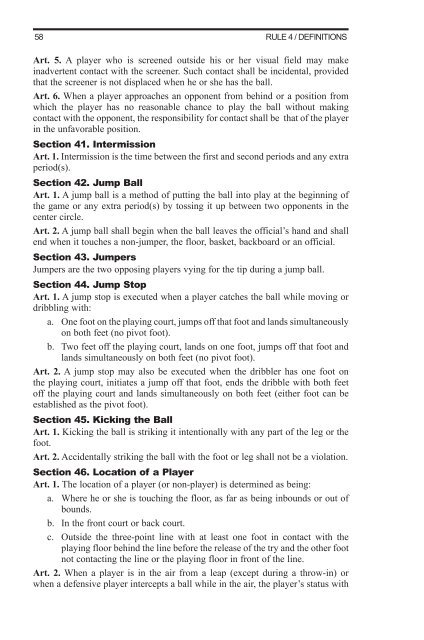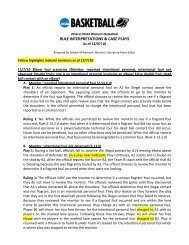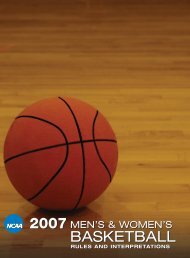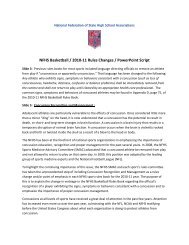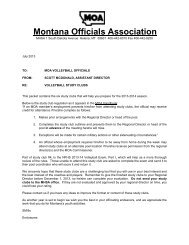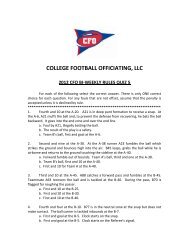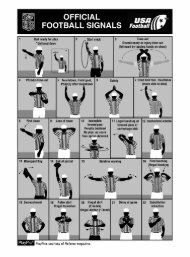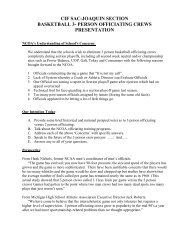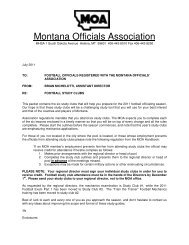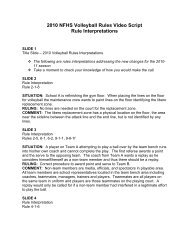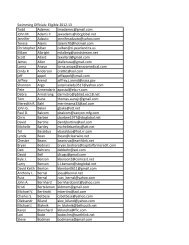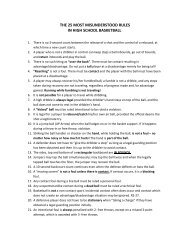2011-12 AND 2012-13 MEN'S AND WOMEN'S RULES - NAIA
2011-12 AND 2012-13 MEN'S AND WOMEN'S RULES - NAIA
2011-12 AND 2012-13 MEN'S AND WOMEN'S RULES - NAIA
You also want an ePaper? Increase the reach of your titles
YUMPU automatically turns print PDFs into web optimized ePapers that Google loves.
58<br />
RULE 4 / DEFINITIONS<br />
Art. 5. A player who is screened outside his or her visual field may make<br />
inadvertent contact with the screener. Such contact shall be incidental, provided<br />
that the screener is not displaced when he or she has the ball.<br />
Art. 6. When a player approaches an opponent from behind or a position from<br />
which the player has no reasonable chance to play the ball without making<br />
contact with the opponent, the responsibility for contact shall be that of the player<br />
in the unfavorable position.<br />
Section 41. Intermission<br />
Art. 1. Intermission is the time between the first and second periods and any extra<br />
period(s).<br />
Section 42. Jump Ball<br />
Art. 1. A jump ball is a method of putting the ball into play at the beginning of<br />
the game or any extra period(s) by tossing it up between two opponents in the<br />
center circle.<br />
Art. 2. A jump ball shall begin when the ball leaves the official’s hand and shall<br />
end when it touches a non-jumper, the floor, basket, backboard or an official.<br />
Section 43. Jumpers<br />
Jumpers are the two opposing players vying for the tip during a jump ball.<br />
Section 44. Jump Stop<br />
Art. 1. A jump stop is executed when a player catches the ball while moving or<br />
dribbling with:<br />
a. One foot on the playing court, jumps off that foot and lands simultaneously<br />
on both feet (no pivot foot).<br />
b. Two feet off the playing court, lands on one foot, jumps off that foot and<br />
lands simultaneously on both feet (no pivot foot).<br />
Art. 2. A jump stop may also be executed when the dribbler has one foot on<br />
the playing court, initiates a jump off that foot, ends the dribble with both feet<br />
off the playing court and lands simultaneously on both feet (either foot can be<br />
established as the pivot foot).<br />
Section 45. Kicking the Ball<br />
Art. 1. Kicking the ball is striking it intentionally with any part of the leg or the<br />
foot.<br />
Art. 2. Accidentally striking the ball with the foot or leg shall not be a violation.<br />
Section 46. Location of a Player<br />
Art. 1. The location of a player (or non-player) is determined as being:<br />
a. Where he or she is touching the floor, as far as being inbounds or out of<br />
bounds.<br />
b. In the front court or back court.<br />
c. Outside the three-point line with at least one foot in contact with the<br />
playing floor behind the line before the release of the try and the other foot<br />
not contacting the line or the playing floor in front of the line.<br />
Art. 2. When a player is in the air from a leap (except during a throw-in) or<br />
when a defensive player intercepts a ball while in the air, the player’s status with


